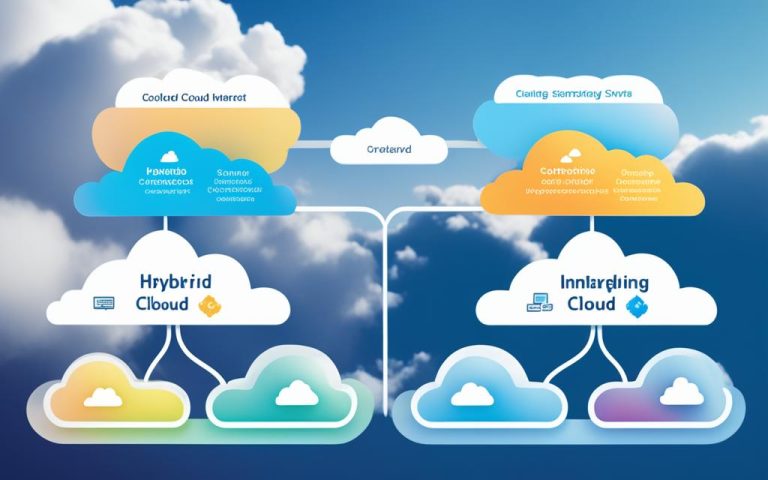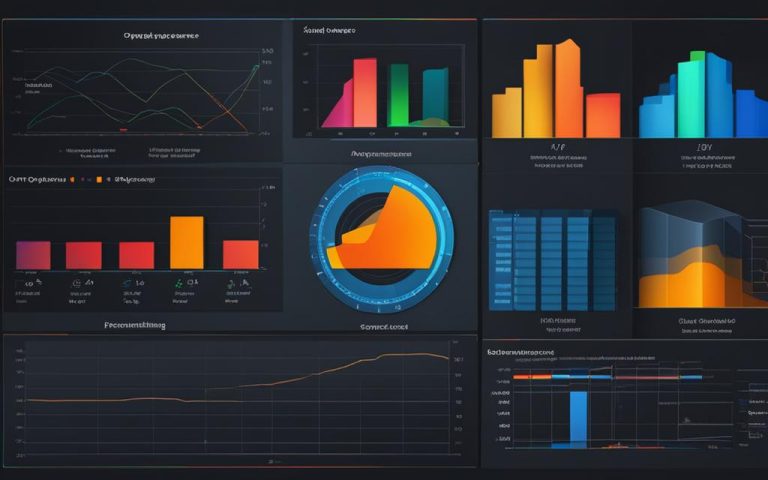In today’s rapidly evolving digital landscape, cloud services are playing a crucial role in enabling organizations to scale their operations, improve efficiency, and achieve operational agility. However, managing operating system configurations in cloud networks is a critical aspect that organizations must handle effectively to maximize the benefits of cloud services.
OS configuration management, also known as cloud configuration management, involves maintaining and optimizing the changes in virtual machines, storage resources, networks, and applications within a cloud infrastructure. By implementing effective cloud configuration management practices, organizations can enhance security, streamline operations, and maintain compliance with industry standards.
Automation and centralized control are key pillars of successful cloud configuration management. With automation, organizations can minimize manual configuration activities, reducing the risk of human error and improving overall efficiency. Centralized control allows organizations to have a single point of control for managing configurations across the entire cloud network, providing real-time visibility and enabling rapid response to changes.
Through cloud configuration management, organizations can harness the power of cloud services while ensuring the security, reliability, and compliance of their operating systems. Automation and centralized control are the driving forces that enable organizations to unlock the full potential of cloud services and optimize their operations.
Importance of Cloud Configuration Management
Cloud configuration management is an essential practice that plays a vital role in ensuring security and compliance in cloud environments. With the dynamic nature of cloud services, managing configurations becomes crucial to minimize the risk of misconfigurations that can expose security vulnerabilities.
Implementing good configuration management practices not only reduces these risks but also helps organizations maintain a secure and compliant cloud infrastructure. By following industry best practices and leveraging powerful configuration management tools, organizations can streamline operations and enhance overall efficiency.
Let’s take a closer look at how cloud configuration management addresses key aspects such as security, compliance, automation, and centralized control.
Security
The security of cloud environments heavily relies on effective configuration management. Properly managing configurations helps organizations prevent security breaches and vulnerabilities that may result from misconfigurations.
By implementing robust configuration management practices, organizations can:
- Ensure secure access controls and minimize the risk of unauthorized access.
- Enforce security policies and encryption measures to protect sensitive data.
- Facilitate incident response planning and enable rapid detection and response to security threats.
- Maintain a secure default configuration for all cloud resources and applications.
- Streamline vulnerability remediation processes to address security weaknesses efficiently.
Compliance
Cloud configuration management also plays a critical role in maintaining compliance with regulatory standards and industry best practices.
By effectively managing configurations, organizations can:
- Safeguard data privacy and integrity in accordance with regulatory requirements.
- Generate compliance reports to demonstrate adherence to various standards.
- Implement and enforce security controls to meet specific compliance requirements.
Automation
Automation is a key benefit of cloud configuration management, enabling organizations to optimize operations and reduce manual overhead.
With configuration management tools, organizations can:
- Automate the deployment and management of cloud resources and applications.
- Ensure consistency and eliminate human errors that often occur during manual configuration.
- Enable scaling and efficient provisioning of resources through automated processes.
- Streamline change management by automating configuration updates across the cloud environment.
Centralized Control
Centralized control provided by configuration management tools allows organizations to have a unified view and management of their cloud infrastructure.
With centralized control, organizations can:
- Efficiently manage and monitor configurations across multiple cloud services and providers.
- Implement standardized configuration policies and templates.
- Track changes and enforce version control to ensure consistency and operational stability.
- Facilitate collaboration and coordination among teams involved in cloud configuration management.
By embracing cloud configuration management practices and leveraging automation and centralized control, organizations can ensure a secure, compliant, and efficient cloud environment.
| Benefits of Cloud Configuration Management | Challenges in Cloud Configuration Management |
|---|---|
|
|
Components of Cloud Configuration Management
Cloud configuration management involves various components that work together to define, provide, and maintain the intended state of cloud resources and applications. These components play crucial roles in ensuring proper configuration and management, allowing organizations to achieve their desired operational state.
Cloud Computing Platform
The cloud computing platform is the foundation of the cloud infrastructure. It provides the necessary resources and services for running applications and storing data. Popular cloud computing platforms include Amazon Web Services (AWS), Microsoft Azure, and Google Cloud Platform.
Cloud Deployment Model
The cloud deployment model determines how cloud resources are provisioned and accessed. It can be public, private, hybrid, or multi-cloud. Each model has its advantages and considerations in terms of security, scalability, and cost-effectiveness.
Network Configurations
Network configurations include the setup and management of networking resources within the cloud environment. This involves defining network topologies, establishing connectivity, and configuring firewall rules and routing protocols.
Compute Configurations
Compute configurations involve the provisioning and management of virtual machines (VMs) or containers within the cloud infrastructure. It includes specifying resource allocations, operating systems, software installations, and startup scripts.
Storage Settings
Storage settings encompass the configuration and management of data storage within the cloud environment. This includes selecting appropriate storage types, configuring access controls, and implementing data replication and backup strategies.
Security Policies
Security policies define the rules and measures to protect cloud resources from unauthorized access, data breaches, and other threats. It includes access control policies, encryption settings, identity and access management configurations, and security monitoring mechanisms.
Deployment and Migration Path
The deployment and migration path outlines the processes and strategies for deploying and migrating applications and data to the cloud environment. It includes release management, testing, deployment automation, and data migration plans.
By understanding and effectively managing these components, organizations can ensure the proper configuration and management of their cloud resources, leading to enhanced security, streamlined operations, and the ability to achieve desired operational states.
Benefits of Cloud Configuration Management
Cloud configuration management offers several benefits to organizations. It enables effective access control management, ensuring that only authorized individuals or systems have access to resources. Configuration management also provides accountability through audit trails, automates security controls, enforces encryption policies, improves security posture, supports incident response planning, increases compliance with regulatory standards, enables rapid detection and response to security issues, implements secure defaults, and facilitates vulnerability remediation. These benefits contribute to maintaining a secure and efficient cloud environment.
Cloud configuration management plays a crucial role in strengthening access controls and enforcing security policies. By effectively managing configurations, organizations can minimize unauthorized access and mitigate the risk of data breaches.
One of the key benefits of cloud configuration management is access control management. Organizations can define granular access policies and ensure that only authorized users have the necessary privileges to access resources. This reduces the risk of unauthorized access and helps maintain data confidentiality.
Moreover, configuration management provides accountability through detailed audit trails. It allows organizations to track changes made to configurations, identify potential vulnerabilities, and pinpoint the responsible parties in case of security incidents. This level of accountability promotes transparency and helps organizations maintain compliance with industry regulations.
Automation is another significant advantage of cloud configuration management. Organizations can leverage automated security controls, such as automated patch management and configuration validation, to reduce the risk of misconfigurations and enhance their overall security posture. These automated controls ensure that systems and applications are configured according to security best practices, minimizing the likelihood of security vulnerabilities.
Additionally, configuration management enforces encryption policies to protect sensitive data. By implementing encryption at rest and in transit, organizations can safeguard their data from unauthorized access or disclosure. Encryption policies can be applied consistently across various cloud environments, ensuring data security in a multi-cloud or hybrid cloud setup.
Furthermore, effective configuration management improves an organization’s security posture. It enables organizations to assess and monitor their systems’ security configurations, ensuring they align with industry standards and best practices. This proactive approach to security strengthens an organization’s ability to defend against potential threats.

| Benefit | Description |
|---|---|
| Access Control Management | Ensures authorized access to resources |
| Accountability | Creates audit trails and tracks configuration changes |
| Automated Security Controls | Automates patch management and configuration validation |
| Encryption Policy | Enforces encryption at rest and in transit |
| Security Posture | Improves overall security configuration and alignment with best practices |
| Incident Response Planning | Supports effective incident response and mitigation |
| Compliance | Helps organizations maintain regulatory compliance |
| Rapid Detection and Response | Enables faster identification and response to security incidents |
| Secure Defaults | Ensures secure configurations as the default setting |
| Vulnerability Remediation | Facilitates identification and remediation of vulnerabilities |
Additionally, configuration management supports incident response planning. Proper configuration management processes and tools enable organizations to effectively detect, investigate, and respond to security incidents. This enhances incident management capabilities and reduces the impact of potential breaches.
To maintain compliance with regulatory standards, configuration management ensures that organizations’ cloud environments meet the necessary requirements. By enforcing security controls, monitoring configurations, and implementing security best practices, organizations can demonstrate compliance during audits and avoid penalties or legal implications.
Rapid detection and response to security issues is crucial in minimizing the impact of potential breaches. Configuration management enables organizations to analyze configuration changes in real-time, detect any anomalies or unauthorized modifications, and respond promptly to mitigate risks.
Configuration management also establishes secure defaults. By making secure configurations the default settings, organizations can minimize the possibility of misconfigurations and human errors. This approach reduces the attack surface and helps prevent security incidents caused by misconfigured resources.
Lastly, configuration management enables organizations to identify and address vulnerabilities efficiently. By regularly assessing configurations and proactively scanning for vulnerabilities, organizations can remediate security risks before they are exploited by attackers.
Summary:
Cloud configuration management offers a range of benefits, including effective access control management, accountability, automated security controls, encryption policy enforcement, improved security posture, incident response planning support, compliance with regulatory standards, rapid detection and response to security issues, secure defaults, and vulnerability remediation. These benefits contribute to maintaining a secure and efficient cloud environment.
Challenges in Cloud Configuration Management
Cloud configuration management presents several challenges for organizations operating in complex cloud environments. These challenges include:
- Complexity: The dynamic nature of the cloud environment introduces complexity, making it challenging to effectively manage configurations.
- Multi-Cloud and Hybrid Cloud Settings: Managing configurations across multi-cloud and hybrid cloud settings adds complexity and may require specialized resources and methods.
- Cost: Misconfigurations or overprovisioning can result in unexpected expenses, making cost management a significant challenge.
- Lack of Native Tools: Organizations may encounter difficulties in meeting complex configuration requirements due to a lack of native tools.
- Human Error: Configuration management errors caused by human mistakes can lead to security breaches and operational issues.
- Inadequate Deployment Planning: Poor deployment planning can result in configuration management issues and project failure.
- Scalability Issues: As organizations grow and require changes to configurations, managing scalability can become challenging.
- Inconsistent Change Management: Untracked or unapproved configuration changes due to inconsistent change management practices can disrupt operations.
- Limited Visibility: Limited visibility into configuration states can hinder effective monitoring and troubleshooting efforts.
- Compliance: Ensuring compliance with regulatory requirements, especially for highly-regulated industries, can be particularly challenging.
Addressing these challenges requires robust cloud configuration management strategies and the adoption of appropriate tools and practices.
Example of the Challenges in Cloud Configuration Management
“Managing configurations across multiple cloud providers poses a considerable challenge for organizations in terms of complexity and resource allocation. Lack of native tools further exacerbates the difficulty of achieving consistent configurations. Without adequate visibility into configuration states, organizations struggle to monitor changes effectively and ensure compliance with regulatory requirements.”
| Challenges | Cloud Configuration Management |
|---|---|
| Complexity | Efficient management of configurations in a dynamic cloud environment. |
| Multi-Cloud and Hybrid Cloud Settings | Managing configurations across multiple cloud providers and hybrid cloud environments. |
| Cost | Ensuring cost-effective management of configurations and avoiding unexpected expenses. |
| Lack of Native Tools | Challenges arising from a lack of native tools for meeting complex configuration requirements. |
| Human Error | Errors in configuration management caused by human mistakes. |
| Inadequate Deployment Planning | Challenges resulting from poor deployment planning. |
| Scalability Issues | Managing configurations effectively as organizations grow and require changes. |
| Inconsistent Change Management | Difficulty in tracking and managing configuration changes consistently. |
| Limited Visibility | Lack of comprehensive visibility into configuration states and changes. |
| Compliance | Ensuring compliance with regulatory requirements in cloud configurations. |
Best Practices for Cloud Configuration Management
To ensure effective management of cloud configurations, organizations should adhere to best practices. By implementing these practices, organizations can optimize their cloud environment, enhance security, and meet regulatory requirements.
1. Infrastructure as Code (IaC)
Using Infrastructure as Code principles allows organizations to define and manage infrastructure configurations in a consistent and scalable manner. IaC enables the automation of infrastructure deployment and ensures reproducibility, reducing the risk of configuration errors and enhancing efficiency.
2. Purpose-Built Tools
Leveraging purpose-built tools designed specifically for cloud configuration management can significantly improve efficiency and accuracy. These tools provide features such as templates, predefined policies, and workflows, enabling organizations to easily manage and maintain their configurations in the cloud environment.
3. Least Privilege
Adhering to the principle of least privilege ensures that only authorized individuals or systems have access to cloud resources and configurations. By granting minimal privileges necessary for specific tasks, organizations can reduce the risk of unauthorized access and potential security breaches.
4. Automation
Automation plays a crucial role in minimizing manual configuration activities, reducing the chance of human error and ensuring consistency across the cloud environment. Automated processes can include configuration deployment, monitoring, and remediation, enhancing efficiency and reliability.
5. Employee Training
Providing comprehensive training and upskilling opportunities for employees involved in configuration management is critical. This training ensures that employees understand best practices, are familiar with the organization’s policies and procedures, and can effectively contribute to maintaining secure and compliant configurations.
6. Continuous Monitoring
Implementing continuous monitoring solutions allows organizations to detect security issues promptly and respond effectively. By regularly monitoring configurations, organizations can identify potential vulnerabilities, unauthorized changes, or non-compliance with security policies, enabling timely remediation.
7. Compliance Reporting
Streamlining compliance reporting processes is essential in meeting regulatory requirements. Organizations should implement robust reporting mechanisms that provide visibility into the configuration state, changes, and compliance status. These reports help organizations demonstrate compliance and identify areas that require improvement.
By following these best practices, organizations can effectively manage their cloud configurations, enhance security, and streamline operations. The table below summarizes the key best practices for cloud configuration management:
| Best Practices |
|---|
| Infrastructure as Code (IaC) |
| Purpose-Built Tools |
| Least Privilege |
| Automation |
| Employee Training |
| Continuous Monitoring |
| Compliance Reporting |
Implementing these best practices enables organizations to effectively manage their cloud configurations, ensuring security, compliance, and operational efficiency.
Identity and Access Management in Cloud Configuration
In the realm of cloud configuration management, identity and access management (IAM) plays a pivotal role. IAM is responsible for managing the authentication and authorization processes that govern the access control of users and services within the cloud environment.
Authentication confirms the identities of users and services before granting access to resources, while authorization defines the level of access privileges based on predefined rules and policies.
To ensure secure and efficient access control, cloud environments employ various models such as Role-Based Access Control (RBAC) and Attribute-Based Access Control (ABAC). These models grant access privileges based on the role a user or service assumes or the attributes they possess.
Implementing Single Sign-On (SSO) and Federation solutions streamline the authentication process across multiple cloud services, simplifying access for users and enhancing security. Users can conveniently access multiple services with a single set of credentials, reducing the complexity of managing multiple accounts.
Monitoring access controls is vital for ensuring the continuous security and compliance of cloud configurations. By regularly monitoring access logs and activities, organizations can detect and address any unauthorized or suspicious access attempts promptly.
Secrets management is also a crucial aspect of IAM in cloud configuration management. Organizations need to effectively manage and safeguard sensitive information, such as API keys, passwords, and encryption keys. Employing robust secrets management practices helps prevent unauthorized access or misuse of these critical assets.
To summarize, IAM is an integral part of cloud configuration management, driving secure and controlled access to cloud resources. By implementing authentication and authorization mechanisms, leveraging access control models, adopting SSO and federation solutions, monitoring access controls, and practicing effective secrets management, organizations can maintain a secure and compliant cloud configuration.
Benefits of Identity and Access Management in Cloud Configuration:
- Enhanced security through authentication and authorization mechanisms
- Efficient access control using Role-Based Access Control (RBAC) and Attribute-Based Access Control (ABAC)
- Streamlined user authentication with Single Sign-On (SSO) and Federation
- Continuous monitoring of access controls to detect and mitigate security risks
- Effective management of sensitive information through secrets management
Conclusion
Cloud configuration management is a critical aspect of operating in the cloud. Organizations that effectively manage and maintain their configurations can reap numerous benefits, including enhanced security, streamlined operations, and compliance with regulatory standards. However, there are challenges to overcome in implementing cloud configuration management.
By following best practices and leveraging appropriate tools, organizations can address these challenges and optimize their cloud configuration management processes. Implementing infrastructure as code (IaC) principles, utilizing purpose-built tools, embracing automation, and providing employee training are some of the recommended best practices.
Furthermore, identity and access management plays a vital role in ensuring the secure authentication and authorization of users and services within the cloud environment. Implementing role-based access control (RBAC), attribute-based access control (ABAC), and monitoring access controls are crucial in maintaining a secure configuration.
In conclusion, cloud configuration management is an indispensable process for organizations to effectively manage their cloud infrastructure and achieve their operational goals. By understanding the benefits, challenges, best practices, and the importance of identity and access management, organizations can build a solid foundation for secure and compliant cloud operations.
FAQ
What is cloud configuration management?
Cloud configuration management refers to the process of effectively managing and maintaining the configurations of cloud resources and applications. It involves centralizing control, automation, and ensuring the proper configuration of virtual machines, storage resources, networks, and applications.
Why is cloud configuration management important?
Cloud configuration management is important because it helps organizations enhance security, streamline operations, and maintain compliance. It reduces the risk of misconfigurations that can lead to security vulnerabilities, provides automation and centralized control, and ensures organizations meet industry standards and regulatory requirements.
What components are involved in cloud configuration management?
Cloud configuration management involves various components, including the cloud computing platform, cloud deployment model, network configurations, compute configurations, storage settings, security policies, and deployment and migration path. Each component plays a crucial role in defining, providing, and maintaining the intended state of cloud resources and applications.
What are the benefits of cloud configuration management?
Cloud configuration management offers several benefits, including effective access control management, accountability through audit trails, automation of security controls, enforcement of encryption policies, improved security posture, support for incident response planning, increased compliance with regulatory standards, rapid detection and response to security issues, implementation of secure defaults, and facilitation of vulnerability remediation.
What are the challenges in cloud configuration management?
Cloud configuration management poses several challenges, including handling the complexity of the dynamic cloud environment, managing configurations across multi-cloud and hybrid cloud settings, cost management, lack of native tools, human error in configuration management, inadequate deployment planning, scalability concerns, inconsistent change management, limited visibility into configuration states, and ensuring compliance with regulatory requirements.
What are the best practices for cloud configuration management?
Best practices for cloud configuration management include using infrastructure as code (IaC) principles, leveraging purpose-built tools, adhering to the principle of least privilege, embracing automation, providing employee training on configuration management practices, implementing continuous monitoring, and streamlining compliance reporting processes.
How does identity and access management relate to cloud configuration management?
Identity and access management is a critical aspect of cloud configuration management. It involves managing authentication and authorization processes to ensure proper access control of users and services within the cloud environment. Role-based access control (RBAC), attribute-based access control (ABAC), single sign-on (SSO), federation, and monitoring access controls are important practices in identity and access management.



















